Who we are
IG Farben plants in Ludwigshafen/Oppau during National Socialism and the war economy
After their 'seizure of power' in January 1933, the systematic transformation of Germany into a 'leader state' and the dismantling of the rule of law by the new regime quickly took place. The decision-makers of I.G. Farben, led by the then chairman Carl Bosch, took advantage of the economic policy objectives of the new rulers to safeguard the interests of the corporation.
Nazification of the working life
The responsible actors at the plant level are bourgeois, politically moderate conservatives. Within the workforce, there was already a Nazi company group before 1933. After the 'seizure of power,' the Nazi ideology soon became pervasive in the everyday operations of the Ludwigshafen/Oppau plants. In 1934, with the Law on the National Order of Labor, the authoritarian 'leader principle' was also introduced into the operational constitution there. The trust council (Vertrauensrat), now with only an advisory function, replaced the freely elected works council. The plant newspaper lost its previously consciously apolitical stance and became increasingly ideologically instrumentalized. Furthermore, mandatory employee assemblies and omnipresent swastika symbols became part of everyday operations.
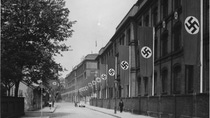
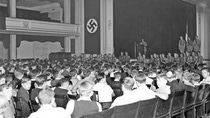
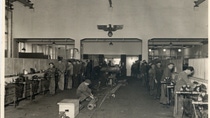
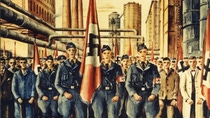
‘Arianization’ of the workforce
Under the impression of the increasing radicalization of the 'Jewish policy' [Nazi term], IG Farben decided at the corporate level in April 1938: All remaining Jewish employees or those classified as Jews by state decree are to be dismissed. Employees defined by the regime as 'Jewish half-breeds' or those living in so-called 'mixed marriages' (with 'Aryan' spouses) were also affected by discrimination and persecution. Similarly, Sinti and Roma as well as political opponents of the regime are also affected.
Of the nearly 25,000 employees at the Ludwigshafen/Oppau plants at the time, 35 individuals were affected by the antisemitic policies of the Nazi regime, according to current knowledge based on extensive research in the company archives. Open antisemitism was not apparent in the implementation of corporate directives at the plant level. Rather, the responsible parties seemed to adopt a predominantly indifferent attitude towards those affected, focused mainly on a correct 'processing' of the situation.
More about discriminated and persecuted employees of the IG Farben plants Ludwigshafen/Oppau
Autarky and rearmament
The economic policy of the Nazi regime has been characterized by state regulation since 1933, and particularly since 1936 with the announcement of the 'Four-Year Plan' to establish Germany's economic and military war capability. With the help of a 'managed economy,' the state-prescribed goals of autarky (independence from imports) and rearmament were to be achieved. Synthetic products, whose manufacturing processes have been developed and produced at the Ludwigshafen/Oppau plants, played a central role in this.
The shares of the Ludwigshafen/Oppau plants in the investment volumes of IG Farben were correspondingly large. This is already reflected in the early years of the regime through the construction of new facilities and the expansion of existing ones. In the Oppau plant, this primarily concerned the production of nitrogen and methanol, while in the Ludwigshafen plant, particularly the production of plastics sees significant growth, as the sales of these new materials also benefited from the policies of autarky and rearmament. Additionally, the fuel synthesis developed in Ludwigshafen based on coal hydrogenation experienced significant expansion. Rising production and sales revenues in these areas contributed significantly to the positive profit development of IG Farben.
Wartime economy and forced labor
With the onset of World War II, the Ludwigshafen/Oppau plants became increasingly important as suppliers of intermediate products for armaments production. This was supported by the construction of the third IG Farben facility for the production of synthetic rubber Buna at the Ludwigshafen plant, which went into production in 1943.
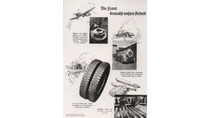
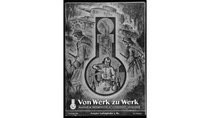
The wartime economic significance of the Ludwigshafen/Oppau plants extends beyond their own production capacities on-site. In the Ludwigshafen plant, the planning of facilities for all hydrogenation plants established during the 'Third Reich' for fuel synthesis takes place. The Ludwigshafen/Oppau plants also play an important, albeit not the sole, key role in the state-sponsored expansion and development of German synthetic rubber production. In addition to their scientific and technological contributions, this is primarily due to the design and construction planning that takes place in Ludwigshafen for all four Buna plants of IG Farben. In this context, the plant also provides a large portion of the specialized personnel necessary for the construction and operation of the Buna plants—from skilled workers and foremen to craftsmen, chemists, and engineers. This is also the case for the fourth Buna plant, which I.G. Farben began constructing near the Auschwitz concentration camp in 1941.
The role of IG Farben in the production of chemical warfare agents and Zyklon B
IG Farben used concentration camp prisoners on its factory premises in Auschwitz-Monowitz from the very beginning. From October 1942, it operated the first company-owned concentration camp there. Employees delegated from the Ludwigshafen/Oppau plants became accomplices and some of them also accomplices in the exploitation and physical extermination of concentration camp prisoners at the company's construction site in Auschwitz-Monowitz. Academic research estimates the number of deaths among the concentration camp prisoners deployed there at around 25,000.
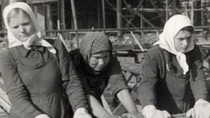
[Source: BASF Corporate History; Photographer: unknown]
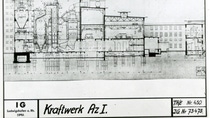
From the beginning of the war, the male workforce at the Ludwigshafen/Oppau plants is increasingly drafted into the Wehrmacht for military service. To compensate for the resulting labor shortage in the factories, more and more forced laborers, prisoners of war and deportees from German-occupied countries in Europe were deployed from 1940 onwards. In total, more than 30,000 people were forced to work in the Ludwigshafen/Oppau factories during the war; concentration camp prisoners were not among them. The working and living conditions were inhumane, especially for the most discriminated against workers from Poland, Ukraine and other Eastern European countries. Many forced laborers die due to the conditions of their forced labor. The local management supported the gradual radicalization of the Nazi regime's labour mobilization and clearly did nothing to improve the working and living conditions of the forced labourers.
Reappraisal and compensation
BASF is committed to the history of IG Farben plants Ludwigshafen/Oppau at its current Ludwigshafen site and to its role within the Nazi economic system. BASF is therefore taking a critical look at its site history and keeping the memory alive.
For a long time after the end of the Second World War, forced laborers were among the forgotten victims of the Nazi regime and the companies in which they had been deployed. Forced labor at today's BASF site in Ludwigshafen was first addressed in a public exhibition in 1990. This was followed in 2002 by the publication of a scientific history of the company.
BASF is a co-founder of the Foundation Initiative of German Business created in 1999, which in the following year establishes the Foundation Remembrance, Responsibility and Future together with the German Federal Government. BASF contributes around 70 million euros to the foundation's capital, which is used to make payments to former forced laborers from 2001 to 2007.
In 2021, BASF founds its initiative Remember. Reflect. Rethink. Its aim is to firmly establish a future-oriented culture of remembrance within the company.